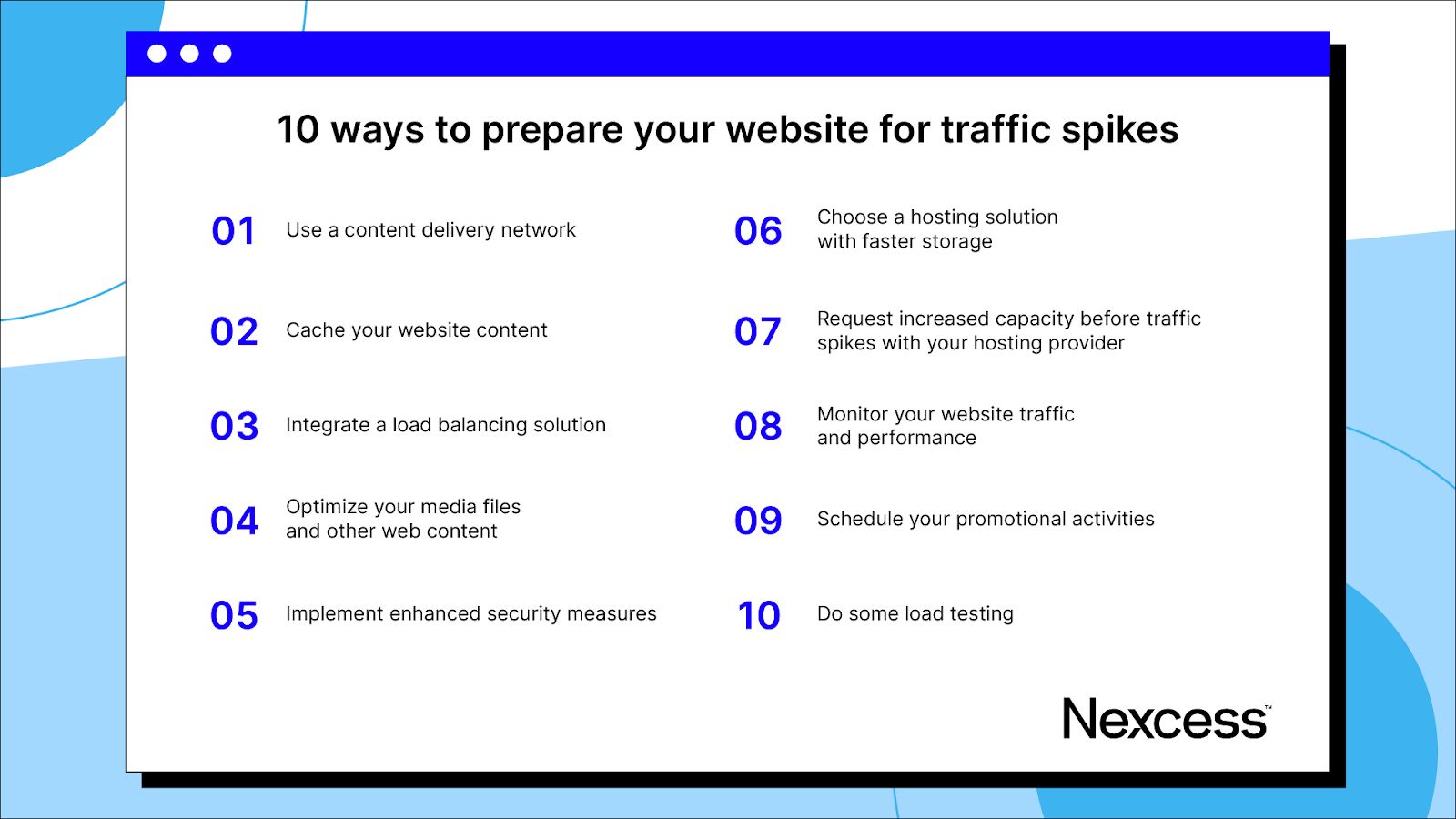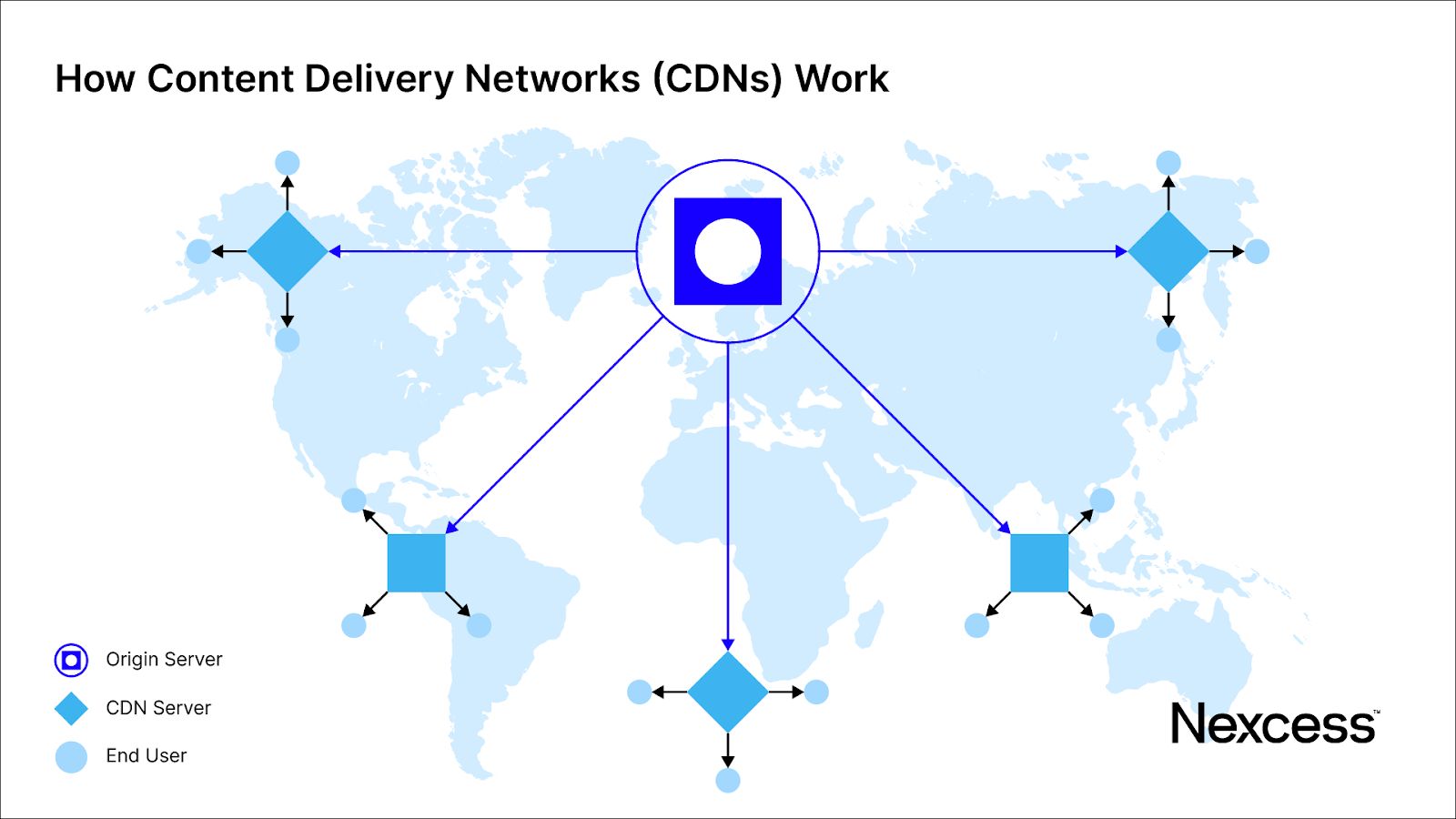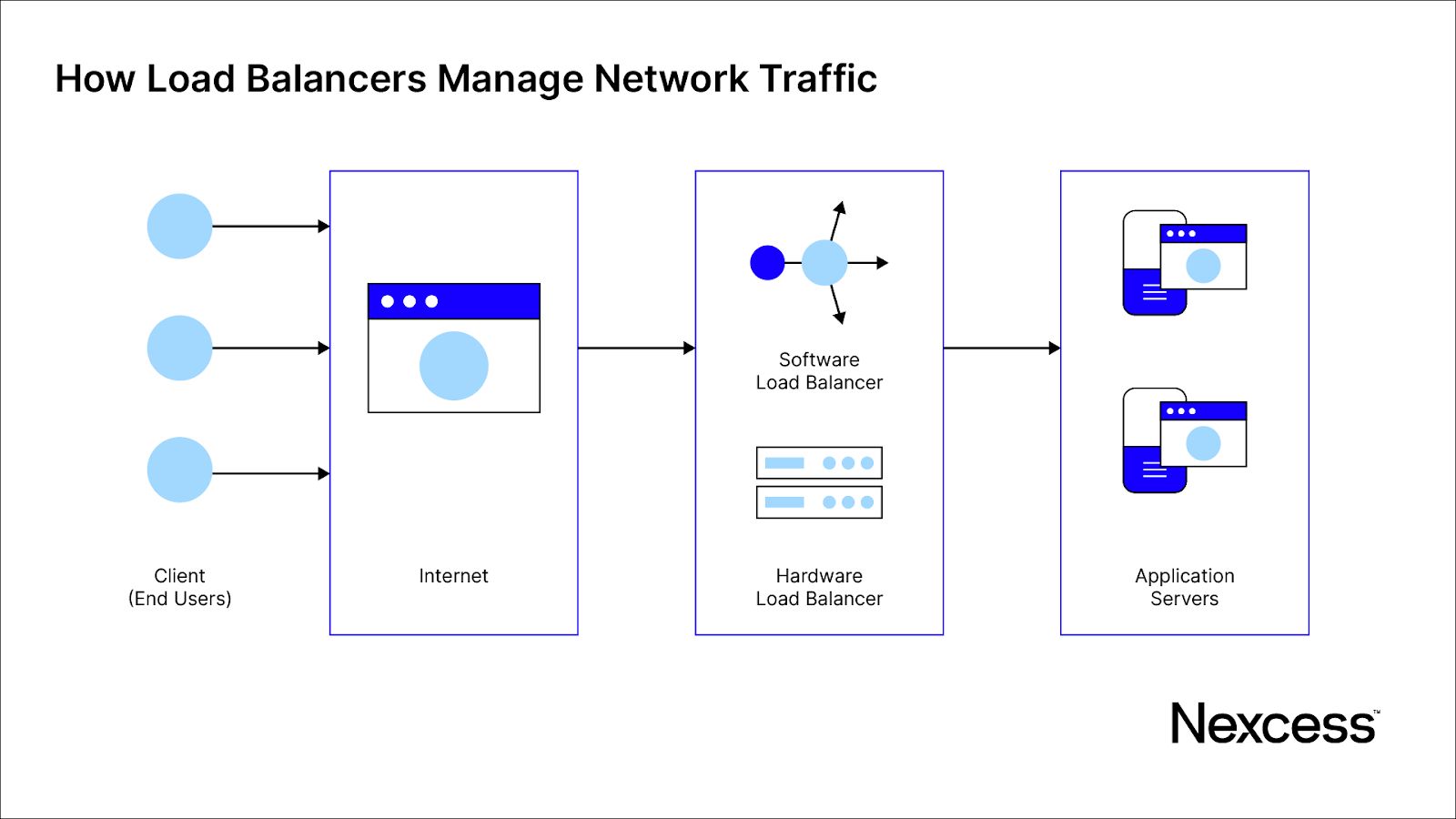When you create a website, you expect people to visit it. After all, you’ve spent all that time, effort, and money building a great-looking online showcase for your business or personal brand. It would be a shame if no one paid any attention to it.
But there are consequences for receiving too much attention. A massive increase in visitors could even crash your website.
But how do you predict or prepare for a sudden spike in website traffic?
In this guide, we’ll cover the steps you should take to ensure your website doesn’t crumble under the weight of a sudden influx of traffic.
- What causes sudden spikes in website traffic?
- Can a website crash due to high traffic?
- How to prepare your website for traffic surges
- Final thoughts: 10 tips for preparing your website for web traffic spikes
Nexcess scales with any traffic surge
Maintain speed, security, and a good customer experience with Nexcess managed hosting
What causes sudden spikes in website traffic?
A web traffic spike is a massive and sometimes unexpected increase in internet activity on a website. You could liken it to a physical location, like a supermarket experiencing a sudden influx of customers far higher than it usually handles — even during peak shopping periods.
Although more visitors can equal more awareness or profit, a traffic surge can have negative consequences if your website is unprepared. They include a poor customer experience, negative visitor reviews, and a stressful time for everyone involved.
Some web traffic spikes result from planned actions on the website owner's part, while others are entirely unexpected. Here are some of the most common causes of web traffic spikes:
- Successful marketing campaign: When online or offline promotional activities for your business include mentions of or links to your website, a spike in web traffic from ad conversions is likely. The size of this spike depends on how successful your campaign is.
- News coverage: Sometimes, you or your business may end up in the news, which could cause a web traffic spike for your website. This can happen with both traditional news sources (radio and television) and online media (news websites and social media).
- Search engine optimization (SEO): Optimizing your website’s content to improve its search engine ranking can make it more visible on the search engine results pages (SERPs) and drive more traffic.
- Malicious bot attack: A distributed denial of service (DDoS) attack uses a network of compromised systems to direct large amounts of internet traffic toward a target to overwhelm it.
Can a website crash due to high traffic?
Increased internet traffic can cause a website to crash if it’s not adequately protected, and this can happen in several ways. For example, you may run out of allocated bandwidth for your website due to all the people simultaneously sending and receiving data.
This scenario is possible if your hosting plan has a bandwidth limit. Once you hit the limit, the website becomes inaccessible.
Another possibility is that a traffic surge may overwhelm the hosting server’s hardware. The server’s processor or the hard drive’s read and write speeds may be too slow.
That will cause slow loading times for visitors as they wait for the server to handle their page requests. It can even cause your website to become unresponsive.
Slow loading times can frustrate visitors, leading to a potential drop in conversions or increase in your bounce rate. In fact, a 2022 Portent study found that an ecommerce website that loads in one second has 2.5 times the conversion rate of a website that loads in five seconds.
How to prepare your website for traffic surges

With the right measures in place to handle a surge, you can reap the benefits of increased visibility or stay protected from dangerous actors, depending on the source of the traffic.
Use a content delivery network

Content delivery networks (CDNs) are networks of geographically distributed servers that can cache web content and make it more accessible to end users. When there’s a traffic spike, multiple servers share the load, and these servers are built to handle the increased traffic.
Most CDNs also offer protection against DDoS attacks from bots that can cause traffic spikes. This feature makes CDNs a good investment for the welfare of your website. There are several CDN services available, like Cloudflare and Fastly, that offer a variety of features and add-ons.
You also could choose a hosting provider that offers CDN access. For example, Nexcess provides access to its Edge CDN powered by Cloudflare with its fully managed hosting plans.
Cache your content
Caching involves creating a temporary data store of your web content and using it to reduce network requests and improve performance. So, when a visitor sends a request from their browser to your website, your web server can send the cached content instead of using system resources to recompile the various webpage components.
Caching can significantly reduce resource usage. So, the server can handle more page requests sent to your website.
If you use WordPress for your website, you can use a caching plugin, such as WP Super Cache or W3 Total Cache.
Some web hosts, like Nexcess, offer built-in caching with their packages.
Integrate a load-balancing solution

A load balancer could be a piece of physical hardware connected to the network as part of your web host’s infrastructure or an application that runs on some network hardware.
Load-balancing solutions are like CDNs in that they both use a network of servers to improve performance. Where they differ is how they improve performance.
While a CDN uses geographically distributed servers, load balancers typically use a cluster of servers in the same location or close proximity. Also, CDNs focus on distributing web content between their servers, while load-balancing servers primarily direct network traffic.
Load balancers are great at managing network traffic, which makes them perfect for handling the massive influx of HTTP requests that come with a traffic surge.
Typically, they’re available with enterprise hosting packages, dedicated servers, and various VPS hosting solutions.
Optimize your media files and other content
Pictures, videos, and other forms of media make up a substantial amount of a website’s content. While putting the best-quality media on your website seems logical, going about it the wrong way can affect your website’s performance.
Poorly optimized images and videos can slow down load times, so optimizing them is a great way to prepare for heavy traffic.
You can do this by reducing the resolution of images and videos or switching to newer formats that work better for websites, like WebM and WebP.
With WordPress, you can use a plugin to optimize images by compressing them without losing quality. For example, TinyPNG has a bulk optimization feature that allows you to shrink all the images on your website in one go.
There are also plugins to minify HTML, CSS, and JavaScript files for improved site performance.
Implement enhanced security measures
Some traffic surges may result from a malicious attack on your website. Hackers can compromise many internet-connected devices and use them to form a botnet. The hacker can remotely control this botnet to flood a website with network traffic and overwhelm the target’s infrastructure.
A dedicated security solution can mitigate these kinds of attacks by detecting and filtering unwanted internet traffic and alerting you, so you can take other measures.
For example, WordPress security plugins like Solid Security Pro and Sucuri reduce the risk of these attacks overwhelming your WordPress website.
These plugins can monitor incoming connection requests, identify attack patterns, and block all related traffic while alerting you about the risk of an attack. They can also scan and detect malware and other malicious code hackers can use to compromise your website.
Choose a hosting solution with faster storage
The type of storage included with your hosting package can be a bottleneck during high-traffic times. We’re talking about hosting solutions that use mechanical hard disk drives (HDDs) instead of the newer solid-state drives (SSDs).
HDDs are cheaper and more likely to be used with more affordable hosting options, like shared plans. However, they are much slower than SSDs.
You might not notice this speed difference in regular day-to-day traffic. But when you see increased traffic and you’re using HDDs, they’re probably contributing to the slowdown.
If you don't know the type of drive your hosting provider uses, you can ask the support team. If it uses HDDs, you may want to switch to a host like Nexcess that uses SSDs to eliminate that potential bottleneck.
Request increased capacity before spikes with your hosting provider
Sometimes, your website will experience more visitors because of your actions, such as a flash sale. If you’re expecting a traffic surge, you can request an increase in your hosting capacity beforehand.
Opting for a hosting plan you can easily upgrade can make this process more manageable. Some hosts may allow your website to handle additional bandwidth temporarily. For instance, Nexcess offers 24 hours of free autoscaling per month.

Upgrading your hosting package may be the best solution if you expect the website traffic spikes to last longer. Also, see if your hosting provider will let you downgrade your package when traffic has returned to normal.
Monitor your website traffic and performance
Being able to detect a traffic spike quickly means you have more time to react to prevent downtime. This doesn’t necessarily mean having someone keep track of all web activity 24 hours a day.
You can use monitoring solutions to track your website’s performance. Some web hosts, like Nexcess, offer built-in monitoring tools. You also can use third-party monitoring tools like Google Analytics for insights into your website traffic.
Schedule your promotional activities
Marketing activities can be a source of traffic surges. So, it’s important to consider whether a website can handle the extra traffic.
Your marketing and technical teams can work together before a campaign launches to ensure the surge doesn’t cause performance issues. The web team could scale up your hosting infrastructure during the campaign and implement other tips from this list.
When running email marketing campaigns, avoid sending out bulk emails to all customers. Instead, split up and stagger email send times — many marketing platforms support this. This ensures that the site will not be impacted by customers checking on a deal or product on the site simultaneously.
Alternatively, the marketing team also could run a highly targeted campaign that would more effectively get the right audience's attention instead of casting a wider net.
Do some load testing
Load testing (also called stress testing) will help you understand your website’s limits. As part of that, it will help you replicate a high-traffic scenario. That will help you define the threshold of what your website can handle before its performance starts to degrade.
While the results are useful, load testing may cause problems with your hosting provider. So, check the terms and conditions or contact the support team to see what’s allowed beforehand.

A popular tool for load testing is loader.io, which you can use to simulate multiple concurrent connections to your website. You can monitor the results in real time and see when performance drops off.
It should give you an idea of the load your website and hosting plan can handle and whether you need to upgrade.
Final thoughts: 10 tips for preparing your website for web traffic spikes
When it comes to managing websites, you either love or dread traffic surges, depending on how prepared you are to handle them. It’s best not to wait until you experience a spike before you take steps to prevent a disastrous outcome.
You should be able to handle the surge if you have a hosting plan with the right features, proper security monitoring and response measures, and a well-optimized website.
Your hosting plays a very crucial role in preparing for web traffic spikes. Choosing a hosting provider like Nexcess that will handle many of these tasks can ease your mind.
Learn why Nexcess is one of the most trusted names in hosting, and pick a fully managed hosting plan for your website today.

